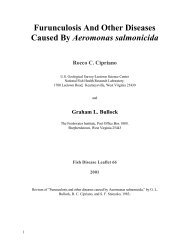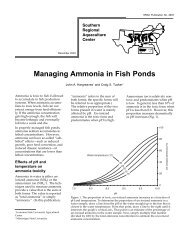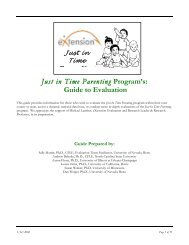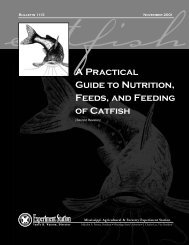Flavobacterium psychrophilum, cause of ... - cop.eXtension.org
Flavobacterium psychrophilum, cause of ... - cop.eXtension.org
Flavobacterium psychrophilum, cause of ... - cop.eXtension.org
Create successful ePaper yourself
Turn your PDF publications into a flip-book with our unique Google optimized e-Paper software.
concentrations from 220 - 440 mg kg -1 day -1 in starter diets and at concentrations <strong>of</strong> 110<br />
mg kg -1 day -1 in pelleted feeds.<br />
Oxytetracycline, however, has proven to be even more effective than sulfonamides for<br />
control <strong>of</strong> BCWD when administered in feed at 75 mg kg -1 day -1 for 10 days (Snieszko<br />
1964, Wood 1968), but the minimum inhibitory concentration to oxytetracycline<br />
(MICOTC) may vary among different isolates and, therefore, affect the efficacy <strong>of</strong><br />
treatment (Bruun et al. 2003). Although there are no drugs currently approved in the<br />
United States by the Food and Drug Administration for treatment <strong>of</strong> BCWD within food<br />
fish, special permission under an Investigational New Animal Drug permit may be sought<br />
in emergency situations for the use <strong>of</strong> terramycin administered as 3.5 g <strong>of</strong> oxytetracycline<br />
per 100 pounds <strong>of</strong> fish for 10 days (Warren 1991).<br />
In Europe, RTFS has been successfully controlled using oxytetracycline at 75 - 300 mg<br />
kg -1 day -1 for 10 – 14 days; amoxicillin at 80 – 100 mg kg -1 day -1 for 7 days; and<br />
florfenicol at 10 mg kg -1 day -1 for 10 days (Branson 1995, Rangdale 1997, 1998; Rimaila-<br />
Parnanen et al. 1997). In a survey <strong>of</strong> antimicrobial resistance patterns conducted with<br />
Danish isolates <strong>of</strong> F. <strong>psychrophilum</strong>, Bruun et al. (2000) found that all <strong>of</strong> the isolates that<br />
they examined were sensitive to florfenicol and that resistance to oxytetracycline had<br />
remained stable over a period <strong>of</strong> five years, while resistance to amoxicillin and oxolinic<br />
acid was increasing. All isolates were also found to carry intrinsic resistance against the<br />
potentiated sulfonamide and sulfadiazine. Izumi and Aranishi (2004) reported finding a<br />
relationship between DNA gyrase (gyrA) mutations and quinolone resistance in F.






